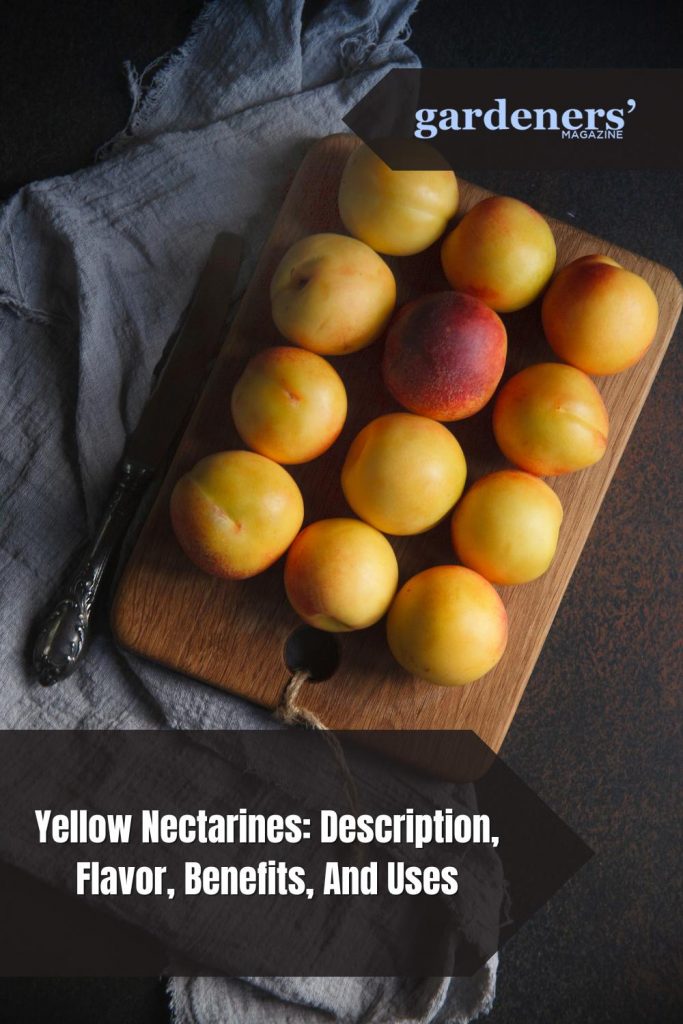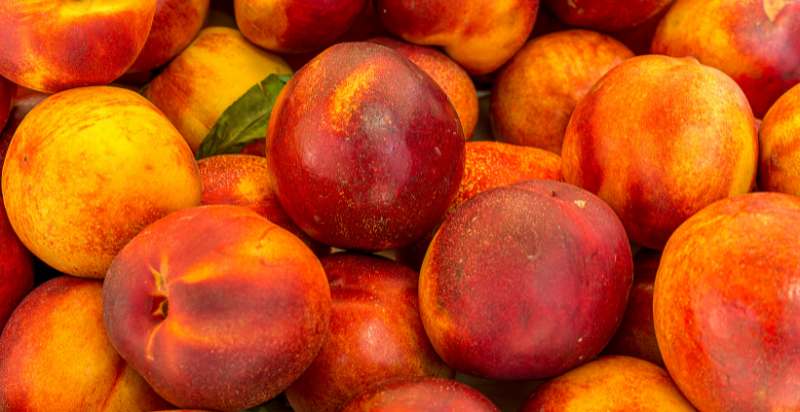Yellow Nectarines are a stone fruit with a large pit in the middle, like other fruits such as peaches, plums, and apricots. Yellow nectarines are a delicious and healthy fruit that offer numerous health benefits. They are rich in vitamins, minerals, fiber, and antioxidants, making them an excellent addition to any diet. Yellow nectarines have a sweet flavor and juicy texture, making them perfect for adding to salads, smoothies, or eating as-is. This article will explore nutrition, health benefits, and tips for selecting and preparing yellow nectarines.
What are Yellow Nectarines?
Yellow nectarines are a type of stone fruit with a large pit in the middle, like other fruits such as peaches, plums, and apricots. The outside of a yellow nectarine is firm and slightly fuzzy, while the inside is usually bright yellow and juicy. Yellow nectarines are a hybrid of peaches and plums, with a sweet flavor similar to both fruits. They are also a good source of antioxidants which help to protect the cells from damage caused by environmental toxins.

History and Origin of Yellow Nectarines:
Yellow nectarines are stone fruit originating from the hillside orchards of China and are noted for their juicy, sweet flavor. They are closely related to peaches and have smooth yellow skin with white flesh inside. Nectarine is derived from the Latin word ‘nectar,’ which means ‘sweet juice.’
The first yellow nectarine was discovered in the 14th century in China and brought to Europe by Spanish explorers. They quickly gained popularity and were cultivated throughout Italy, France, Spain, and Portugal. In 1775, Thomas Jefferson planted a nectarine tree at his home in Monticello, and it is believed that he may have been one of the first to cultivate them in North America.
Today, yellow nectarines are grown worldwide, from California to Chile, South Africa to New Zealand. They can be enjoyed fresh off the tree or cooked into various recipes such as jams, pies, cobblers, and sauces. They are also great for snacking and provide a delicious, juicy flavor.
Description of the Yellow Nectarines:
Yellow Nectarines are medium to large-sized fruits, typically 5–9 cm in diameter and 7–14 cm long. The skin is yellow-orange and smooth, with occasional small lenticels. The flesh is juicy and firm with a sweet flavor. There may be a slight tartness that adds to the depth of flavor. The flesh clings to a single, central pit. Nectarines are rich in vitamins A and C and are a good source of dietary fiber.
Flavor Profile of Yellow Nectarines:
Yellow Nectarines are known for their sweet and juicy flavor. Their flesh is softer than other nectarines, with an almost honey-like texture. When ripe, the skin is yellow and slightly blush red when exposed to the sun. Depending on the variety, some may hint at apricot and honey flavors, while others have an intense sweet-tart taste.
Depending on the variety, some may have a crisp texture while others are velvety and creamy. No matter what, Yellow Nectarines are always a delicious treat! So, if you’re looking for an extra sweet and juicy nectarine, Yellow Nectarines are the perfect choice.
Health Benefits of Yellow Nectarines:
Compared to other fruits like apples and oranges, nectarines are packed with vitamins A, C, E, and potassium. The yellow-fleshed variety of nectarines is rich in carotenoids, powerful antioxidants that help protect cells from damage. Eating yellow-fleshed nectarines may help reduce the risk of heart disease, stroke, and certain types of cancer. They also contain fiber which can help with digestion and help keep blood sugar levels stable. Yellow nectarines are also a good source of folate, which is important for cell growth and development.
Furthermore, eating yellow nectarines can help boost the immune system and prevent colds and other illnesses. Nectarines are low in calories and fat making them an ideal snack for those trying to lose weight or maintain a healthy diet. Finally, yellow nectarines contain a natural sweetener called sorbitol which can help satisfy your sweet tooth without the added calories and sugar of processed sweets.

Cultivation of the Yellow Nectarines:
The Yellow Nectarines require a warm climate with temperatures ranging from 10 to 25°C (50 to 77°F). They grow best in soil rich in organic matter and well-draining soil, such as sandy loam. The trees need full sun exposure for optimal fruiting.
Proper pruning and training should be done to cultivate the Yellow Nectarines to encourage strong, healthy growth. Pruning is best done during the winter months when the tree is dormant. During this time, dead, damaged, or diseased branches and any weak or crossing branches competing for light and resources should be removed.
Trees should also be trained with a central leader structure to promote strong growth and form an evenly-spaced canopy. The Yellow Nectarines should be fertilized twice yearly in the spring and summer with nitrogen, phosphate, potash, micronutrients, and other minerals, depending on soil tests.
These fruits require a warm climate with ample sunshine to thrive, so they grow well in Mediterranean countries. Yellow nectarines need plenty of water and nutrient-rich soil to produce large, juicy fruits. The optimal temperature range for cultivating yellow nectarines is 70 – 85°F (21 – 29°C). They will not tolerate cold weather and frost. Harvesting takes place from summer to early autumn, depending on the variety.
Harvesting of the Yellow Nectarines:
Yellow Nectarines are typically ready for harvest in late summer or early fall. They should be harvested when the fruit is yellow and slightly soft to the touch. It is best to pick them up in the morning before they are exposed to too much heat from the sun.
The fruits can then be kept at room temperature for a few days or stored in the fridge for up to two weeks. After harvesting, the fruit can be enjoyed fresh or used in recipes such as jams and jellies. The Yellow Nectarines also make a great addition to smoothies and salads.
Where Do Yellow Nectarines Grow?
Yellow nectarines are grown mainly in North America, Europe, and Asia. In the United States, they are predominantly grown in California, Washington, and Oregon. The Mediterranean countries of Italy, Spain, and Greece also have a long history of cultivating yellow nectarines. These fruits are an important part of the local agricultural industry in China and Japan. Most yellow nectarines grown in Asia are produced in China, Taiwan, and South Korea.
What are the things you need to keep in mind when buying Yellow Nectarines?
- Select fruits with a bright yellow color and taut skin, as these are usually the ripest nectarines.
- Avoid fruits with bruises or soft spots, as they may be over-ripe or spoiled.
- Check for signs of insect damage, such as webbing or holes in the skin.
- Smell the fruit to ensure it has a sweet, fragrant aroma, indicating freshness and ripeness.
- Give the nectarine a gentle squeeze; it should be ready to eat if it yields slightly. Avoid too hard or squishy fruits, as these may not be ripe.
- Choose heavy fruits for their size, indicating a higher water content and juiciness.
- Buy Yellow Nectarines directly from the grower to ensure you get the freshest product.
- If the nectarines start to soften, consuming them within a few days is best. Unripe fruit can be left at room temperature for several days until ripe.
- Lastly, always wash nectarines before eating or cutting into them to remove any dirt or pesticides
These tips will help you pick the best Yellow Nectarines for your needs.
What is the Best Way to Store Yellow Nectarines?
When storing yellow nectarines, it’s important to keep them in the refrigerator. To ensure they stay fresh for as long as possible, wrap each fruit in a paper towel and store them in an airtight container or plastic bag. This will help prevent moisture from escaping and keep the fruits from bruising or spoiling too quickly. It is also best to avoid stacking the nectarines, which can cause bruising. Finally, using them within a week is best for optimal freshness.
How can Yellow Nectarines be used in Recipes with other Fruits and Vegetables?
Yellow nectarines can be used in various ways to create a delicious and healthy dish. They can be combined with other fruits, such as strawberries, peaches, or apples, to make an easy fruit salad or salsa. Nectarines can also be cooked into a jam or chutney, perfect for topping toast or stirring into yogurt.
For savory recipes, nectarines can be added to salads or grilled with vegetables like peppers and eggplant. They also work well in a stir fry with other veggies such as carrots, zucchini, broccoli, and onions. Lastly, they are great for baking into pies and cobblers with other desired fruit. The options are truly limitless.
Conclusion:
Yellow Nectarines are a delicious and versatile fruit that can be enjoyed in various ways. When selecting them at the grocery store or farmer’s market, be sure to pick the most ripe and fragrant ones. Please keep them in an airtight container or plastic bag in the refrigerator for best storage. They can also be used in sweet and savory recipes to create delicious and healthy dishes. Enjoy
- Everything You Wanted to Know About Red Tamarillos - June 2, 2025
- A Guide to Tulips: Everything You Need to Know & More… - June 2, 2025
- Guanabana: Description, Flavor, Benefits, And Uses - May 27, 2025
